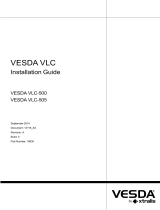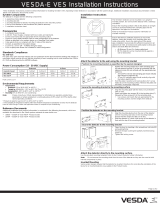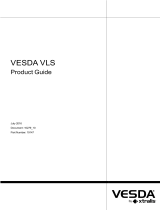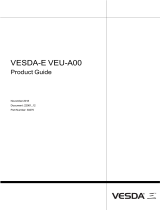Page is loading ...

ASPIRATING PIPE AND FITTINGS
VESDA PIPE INSTALLATION INSTRUCTIONS
General Information
• Always use tools specifically designed for plastic pipe.
• Protective gloves are recommended for use when solvent cementing.
If hands come into contact with cement, use a waterless abrasive
soap.
• Avoid sources of heat or open flames when solvent cementing. Do not
smoke.
• Always chamfer and deburr pipe ends.
• Use the proper solvent cement.
(note; air shipments of solvent cement are forbidden by law).
• Always replace lids on cans when not in use.
• Never dilute solvent cement.
• Keep jointing surfaces dry in wet weather.
• Avoid direct inhalation of fumes. Use in a well-ventilated area.
• Wipe up spills or leaks immediately with clean lint free cloth or paper towels.
• Follow recommended cure times prior to testing the system.
• Prevent excessive solvent cement from running into the pipe or fitting socket.
The Integrity of air sampling systems may be affected if proper CPVC solvent cement is not used. Xtralis disclaims responsibility for
any air sampling pipe system constructed with cements other than those recommended.
Installation Instructions
Main sampling pipes (3/4”) diameter shall be installed as follows:
• Air sampling pipe network calculations shall be provided by Xtralis or a Certified VESDA distributor.
• All solvent cemented connections shall be assembled in accordance with Xtralis recommendations.
• Maximum support spacing for main sampling pipes shall not exceed 5 ft. Hangers and supports used shall be free of rough or
sharp edges and shall not bind the pipe from movement.
• End caps shall be solvent cemented to each main sampling pipe, and drilled with a hole as specified by the ASPIRE Modelling
Program.
• Sampling holes shall be 5/64” diameter, or otherwise appropriately sized to achieve the system performance as specified and
calculated by the system design.
• Sampling points shall not be spaced at more than 30 ft intervals.
• Each sampling point shall be identified with a label.
• Minimum OD of all capillary tube shall be 3/8“.
• Maximum length of any capillary tube shall not exceed 20 ft.
• The capillary tube shall terminate at an approved ceiling sampling point.
Quality
Air Sampling Pipe and Fittings
• Manufactured in strict accordance with ASTM F442 to SDR 13.5 dimensions.
• Fittings per ASTM F438; solvent cement per D2564.
• Pipe and fitting materials per ASTM D1784; NSF Listed Materials.
Design
• Per VESDA System Design Manual, and
• Local codes and standards may apply.
Handling and Storage
Care should be taken at all stages of handling, transportation and storage.
• Brief exposure to direct sunlight may cause discoloration but will not affect physical properties. Piping must be covered with
a non-transparent material when stored outside. This covering must provide adequate air circulation above and around the pipe
as required to prevent excessive heat absorption that can result in discoloration and deformation of the product during long
term storage.
• Pipe should be properly supported in storage to prevent sagging or bending. Pipe should be stored at the job site on level
ground in the packages provided. Caution must be exercised to avoid compression, damage or deformation.
• Thermoplastic pipe must not be stored close to heat producing sources such as heaters, boilers, steam lines, engine exhaust
etc.
• Although VESDA piping products are tough and corrosion resistant, they should not be dropped, have objects dropped on them,
nor subjected to external loads. Pipe must not be dragged across the ground or over obstacles. Impacts such as dropping from
sizable heights and/or rough handling should be avoided, particularly in cold weather. The product shall be inspected for any
scratches, splits or gouges that may have occurred from improper handling or storage. These sections must be cut out and
discarded.

www.xtralis.com All technical data is correct at the time of publication and is subject to changes without notice. All
Intellectual Property including but not limited to trademarks, copyrights, patent are hereby
acknowledged. You agree not to copy, communicate to the public, adapt, distribute, transfer, sell, modify
or publish any contents of this document without the express prior written consent of Xtralis. Installation
information: In order to ensure full functionality, refer to the installation instructions as supplied. © Xtralis
Doc. No. 14932_04
Part No. 18882
October 2021
Fire Resistance
Flammability Rating VO UL 94 Flame Retardant
Limiting Oxygen Index 60 ASTM D2863
Flame Speed 0 ULC
Smoke Generation 025 ULC
Flame Travel 4 UL 1887
Optical Density 0.19 Peak
0.03 Avg.UL 1987
Heat of Combustion 7,700 BTU’s/lb.
Physical
ASTM
Cell Classification 23447 D1784
Specific Gravity 1.55 D792
Tensile Strength 8400 psi D638
Modulus of Elasticity 4.23 x 105 D638
Compressive Strength 9600 psi D695
Izod Impact 3.0 D256A
Coefficient of Linear Expansion 3.4 x 105
Upper Temperature Limit 200°F
Electrical Conductivity Non-conductor
ASPIRATING PIPE AND FITTINGS
TECHNICAL SPECIFICATIONS
Solvent Cementing
Solvent cement welding is a simple and quick means of constructing high integrity leakfree joints. Care must be used to ensure that
the correct solvent cement is used and that joining instructions are followed properly.
BEFORE APPLYING SOLVENT CEMENT, appropriate safety precautions must be taken. Be aware at all times of good safety
practices. Solvent cements are flammable. Eliminate all ignition sources. Do not smoke during use and do not expose to other
sources of heat or flame in working or storage areas. Avoid breathing vapors. Use only with adequate ventilation. Explosion proof
mechanical ventilation or local exhaust is recommended to maintain vapor concentrations below recommended exposure limits.
In confined areas, a NIOSH approved organic vapor cartridge respirator with full-face piece is recommended. Cement should be
stored in the shade at temperatures between 40°F and II0°F Containers should be kept tightly closed when not in use, and covered
as much as possible during use. Avoid contact with eyes. Splash proof chemical goggles are recommended. Avoid frequent contact
with skin. Wearing PVA coated gloves and an impervious apron are recommended. Solvent cements have a limited shelf life and
must be used prior to the expiration date. Refer to printed warnings on cement can and Material Safety Data Sheets for additional
information.
Joining Procedures
The following procedure MUST be followed:
1. The pipe must be cut square. Cutting the pipe as squarely as possible
provides a maximum bonding area. VESDA pipe should be cut with
the VESDA ratchet action tube cutter or a wheel-type plastic tubing
cutter. Care must be taken not to split the pipe if a ratchet type cutter
is used, particularly at colder temperatures.
2. Remove all burrs and filings, and place a slight bevel on the pipe end.
A file or chamfering tool is suitable for this purpose. A proper bevel
will ease entry of the pipe into the fitting socket and prevent solvent
cement from being wiped from the joining surfaces during assembly.
3. Wipe loose dirt and moisture from the fitting socket and pipe end by
using clean dry rag. Check the “dry fit” of the components being joined
to ensure compatibility. The pipe should enter the fitting socket 1/4
to 3/4 of the way. If the pipe bottoms with little interference fit use
extra solvent cement when making the joint.
4. Using the appropriate size applicator (a dauber or natural bristle
brush 1/2 the size of the pipe diameter being joined) apply a medium
even coat of one-step cement to the outside pipe end while working
into the surface. If you were to put one-step cement inside the fitting
it may build up when the pipe is inserted. This build-up will affect
airflow characteristics inside the pipe and may cause unpredictable
behavior. If there was little interference during the dry fit apply a
second coat of cement to the pipe end at this time. It is important
to work quickly so that the cement is still liquid (to allow surfaces to
slide) when pipe and fitting are assembled.
5. Immediately insert the pipe completely into the fitting socket while
rotating the pipe 1/4 turn. Properly align the fitting for installation at
this time. The pipe must bottom to the fitting stop. Hold the assembly
for 10 to 15 seconds to ensure initial bonding. A continuous bead of
cement should be evident around the joint.
6. Wipe off excessive cement with a rag (excessive cement can cause
over-softening resulting in damage). The assembly must be allowed
to set without any stress on the joint for 1 to 5 minutes.
7. The assemblies must be allowed to cure properly prior to use.
Cure times are a function of pipe size, temperature, humidity and
tightness of fit. Refer to following cure times:
Pipe Size 3/4” & 1” 3/4” & 1” 3/4” & 1”
Temprature 60°F to 120°F 40°F to 59°F 0°F to 30°F
Cure Time 1 1/2 hour 4 hour 48 hour
* For estimation purposes, approximately 270 joints can be made per quart of VESDA
CPVC one-step cement.
/








